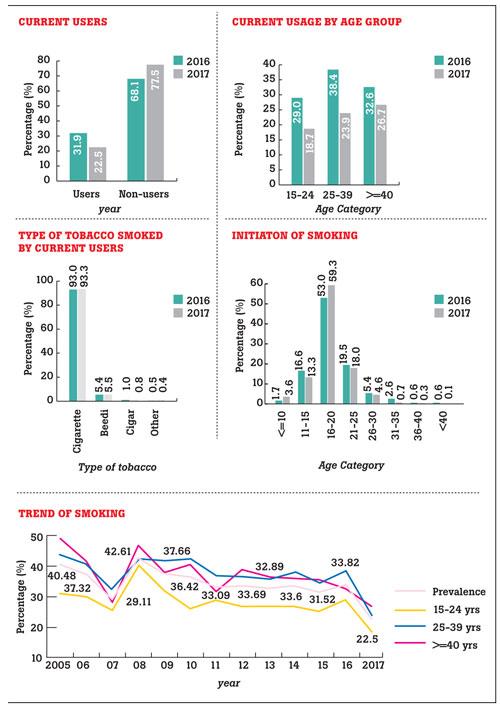World No Tobacco Day 2019 Losing life one lung at a time

The design changes in cigarettes over the past several decades have not only made them both more likely to attract new underage users and more addictive, they have also made cigarettes more lethal. Studies conclude that, today’s cigarette smokers – both men and women – have a much higher risk of lung cancer and chronic obstructive pulmonary disease (COPD) than smokers in the 1960s, despite smoking fewer cigarettes. Moreover, the increased risk of lung cancer is the result of tobacco industry changes to the design and composition of cigarettes.
Annually ‘World No Tobacco day’ is celebrated around the world on the 31st of May. This year the World Health Organization (WHO) has drawn focus onto “tobacco and lung health.” The campaign will increase awareness on; the negative impact that tobacco has on people’s lung health, from cancer to chronic respiratory disease and the fundamental role lungs play with regard to the health and well-being of all people. The campaign also serves as a call to action, advocating for effective policies to reduce tobacco consumption and engaging stakeholders across multiple sectors in the fight for tobacco control.
Tobacco control

As principal scientist at Phillip Morris- the American multinational cigarette and tobacco manufacturing company, W.L Dunn stated in the 1970s, “No one has ever become a cigarette smoker by smoking cigarettes without nicotine.”
Nicotine, a chemical that exists naturally in tobacco plants, is an extremely addictive drug as we know. It is present in smoked tobacco products (e.g., cigarettes, cigars, cigarillos, pipe, waterpipe), smokeless tobacco products and many electronic cigarettes.
Presently, it is not a matter of ignorance that lights up the cigarettes, for the health warnings, the life threats and the ill impact on society caused by smoking is not news to the majority. Unlike in the past, smokers now know their adversary: Nicotine fairly well. Thus, the major driver of the anti-tobacco campaign at this stage is the implementation of tobacco control.
Speaking to the Health Capsule, Senior Lecturer, Department of Psychiatry, Faculty of Medicine, University of Colombo Dr. Mahesh Rajasuriya MD (Psychiatry) contributed his expertise in this regard as well.
“The single most effective measure to curb smoking is to make cigarettes less affordable. This can easily be done by increasing cigarette tax, which would create a win-win situation: The tax revenue to the government increases and due to lowering of tobacco smoking the economic cost reduces. Ban on sale of single sticks of cigarettes further make them unaffordable, especially to the poor and the young, as they then must buy a whole packet. Prohibition of public smoking makes it even more difficult to smoke.
These are some of the effective methods to reduce the availability of cigarettes. The other way to reduce smoking prevalence in a country is to reduce the demand for smoking. Demand reduction is best done by banning direct and indirect cigarette advertising and creating a negative image of smoking. I have personally found that smokers become really motivated to stop smoking when they learn how the tobacco industry has deceived them and how the industry continues to target children and teenagers,” he stated.
According to the 2017 Report on Tobacco Smoking Trends in Sri Lanka by the Alcohol and Drug Information Centre (ADIC) when the price of a cigarette stick was increased in 2016 from Rs. 35 to Rs. 50 (43% increase), of the respondents, 64.6% of current smokers said this price change caused them to change the way they smoked. 87.4% of those who altered their habit, mentioned that the change due to price increase was a “reduction of usage”.
Economic burden
The World Bank states how tobacco use poses an unparalleled health and economic burden worldwide. A new study found that the diseases caused by smoking account for US$ 422 billion in health care expenditures annually, representing almost 6% of global spending on health. Smoking causes close to 6 million deaths per year - more than the deaths from HIV/AIDs, TB and Malaria combined. And the total economic cost of smoking after including productivity losses from death and disability amounts to more than US$ 1.4 trillion per year- equivalent in magnitude to 1.8% of the world’s annual GDP.

The World Bank states how tobacco use poses an unparalleled health and economic burden worldwide. A new study found that the diseases caused by smoking account for US$ 422 billion in health care expenditures annually, representing almost 6% of global spending on health. Smoking causes close to 6 million deaths per year - more than the deaths from HIV/AIDs, TB and Malaria combined. And the total economic cost of smoking after including productivity losses from death and disability amounts to more than US$ 1.4 trillion per year- equivalent in magnitude to 1.8% of the world’s annual GDP.
It is obvious that in low- and middle-income countries like Sri Lanka this heavy burden falls on the impoverished populations.
“Contrary to the lies the tobacco industry spreads, the net economic benefit from tobacco smoking to a country is highly negative. You need to subtract the health costs and economic loss due to death and disease from the tax revenue and job creation due to tobacco business,” Dr. Rajasuriya quipped.
Studies show that tobacco control measures are highly cost-effective and do not harm economies. Though progress is being made in controlling the global tobacco epidemic, existing measures have not yet been used to their full potential. Applying evidence-based interventions, such as significant tobacco tax and price increases, comprehensive smoke-free policies, and bans on all tobacco product advertising, promotion, and sponsorship would reduce the demand for tobacco products and significantly reduce the prevalence of tobacco use and the resulting death, disease, and economic costs.
Nicotine manipulation
As reported by The New York Times in August 2018, tobacco companies have paid social media influencers to promote cigarettes on platforms including Facebook, Instagram and Twitter as part of a marketing strategy documented in more than 40 countries. The influencers are usually young, attractive and have large social media followings. These social media campaigns have been viewed more than 25 billion times worldwide, according to social media analytics.
As reported by The New York Times in August 2018, tobacco companies have paid social media influencers to promote cigarettes on platforms including Facebook, Instagram and Twitter as part of a marketing strategy documented in more than 40 countries. The influencers are usually young, attractive and have large social media followings. These social media campaigns have been viewed more than 25 billion times worldwide, according to social media analytics.
Profiting off the susceptibility of the youth, tobacco companies not only manipulate the addictive properties of their products, they also manipulate the product in ways that both attract starter smokers and enhance the likelihood that they will become regular smokers. Tobacco industry research on nicotine has guided the design of a variety of products over the years.
Not to mention, some argue that newer trends like ‘vaping’ or ‘e-cigarettes’ may be a healthy alternative for smokers and help them to quit or reduce.
Not to mention, some argue that newer trends like ‘vaping’ or ‘e-cigarettes’ may be a healthy alternative for smokers and help them to quit or reduce.
However, Dr. Rajasuriya pointed out that, “this is not the case. Vaping has been shown to sometimes worsen tobacco smoking. The very attractive gadget will lure more young people into the habit of smoking.”
He went on to say that, “new tobacco products such as e-cigarettes and vaping are their (tobacco industry’s) latest gimmick played on the vulnerable, especially young, tech-savvy generation. The tobacco industry and their allies and friends, including certain scientists and health professionals, tend to argue that tobacco smokers need an alternative. What is the basis of this argument? In that case, people who habitually suck on their thumbs or bite their nails, should be given something else to suck or bite!” A 2016 Surgeon General’s report also concluded that youth use of nicotine in any form, including e-cigarettes, is unsafe, causes addiction and can harm the developing adolescent brain.
A growing number of studies have found that young people who use e-cigarettes are more likely to become smokers, and many are low-risk youth who would not have otherwise smoked cigarettes. A January 2018 report by the National Academies of Sciences, Engineering and Medicine (US) concluded, “There is substantial evidence that e-cigarette use increases the risk of ever using combustible tobacco cigarettes among youth and young adults.”
These ‘developments’ therefore are only addicting a new generation of kids and threatening the decades-long progress our nation and the world have made in reducing youth tobacco use.
Fracturing the fad
Inhaling tobacco smoke exposes users to more than 7000 toxicants and at least 70 carcinogens, damaging the whole body. A regular smoker typically loses more than a decade of life.
It wasn’t “cool” then, and it certainly isn’t cool now. In fact, as Dr. Rajasuriya put it, “it is a shameful thing to smoke. It is a shameful thing to work to produce and market cigarettes. It is a violation of the human rights of women and children and non-smokers as the smoker pollutes the atmosphere with disease-causing fumes… Evidence is accumulating to show that tobacco smoking is a risk factor for development of schizophrenia. If you didn’t know already; tobacco smoking causes leathery skin and makes a person look older, compromises blood flow to penis resulting in erectile dysfunction, causes bad breath and the fumes linger hours after smoking a cigarette.”
Inhaling tobacco smoke exposes users to more than 7000 toxicants and at least 70 carcinogens, damaging the whole body. A regular smoker typically loses more than a decade of life.
It wasn’t “cool” then, and it certainly isn’t cool now. In fact, as Dr. Rajasuriya put it, “it is a shameful thing to smoke. It is a shameful thing to work to produce and market cigarettes. It is a violation of the human rights of women and children and non-smokers as the smoker pollutes the atmosphere with disease-causing fumes… Evidence is accumulating to show that tobacco smoking is a risk factor for development of schizophrenia. If you didn’t know already; tobacco smoking causes leathery skin and makes a person look older, compromises blood flow to penis resulting in erectile dysfunction, causes bad breath and the fumes linger hours after smoking a cigarette.”
However the lethality and iniquity of tobacco use is masked by a thin but wide layer of ‘voguish mania’, but like with any other trend, the moment smoking seems out of style, we can expect a massive drop in the tobacco using youth. With the tobacco industry’s business model depending on addicting the next generation of tobacco users to its products, social media companies must take action now to protect young people from the tobacco industry’s predatory marketing practices.
Policies that make tobacco products less affordable, less attractive, less socially acceptable, and less available to youth will reduce the risk of youth addiction to tobacco. Regulating the content of tobacco products, including nicotine, as well as menthol and other flavourings, comprehensively banning advertising, promotion and sponsorship of tobacco products and implementing measures that prohibit the sale of tobacco to persons under the age of 18 and other actions that limit underage access to tobacco products are a few initial steps in this direction.


